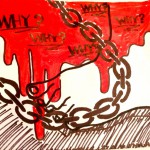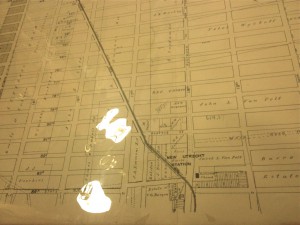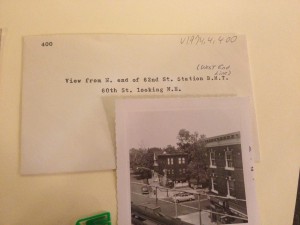The Yellow Wall Paper Re-narrated by John
Yoshiko
My wife hasn’t been doing well recently. Not too long ago I rented a colonial mansion in the country so she could get some rest and relaxation while I tended to my real patients. The place is perfectly refreshing. I thought a nice summer vacation would be all she needed to clear her head. At first, I didn’t think anything serious was wrong with my wife, perhaps some nervousness or something else that could be reasonably fixed.
Right after we moved in, she told me that there was something strange about the house, and she could felt it. I knew that she was still a bit nervous because she hadn’t gotten used to the new environment. It happens to anybody, so I just told her that what she felt was a draft, and shut the window for her. Then she felt completely relieved.
I set her up in a room that was once used as a nursery. It was the most logical room, as my wife needs all the sun and air she can get, and this room is very spacious and open with plenty of air circulating through. Immediately my wife protested and wanted a room closer to the ground floor but as a physician, I let her know this is what’s best for her. She immediately had the problem with the wallpaper in the room. I told her I would re-paper it but I got so busy with my real patients that I put it off for a while until I realized if I changed the wallpaper, it would just be something else that would end up getting the best of her and before you know it, I would be remodeling the whole entire mansion and we’re only supposed to be here for 3 months, so I let her know it’s her nervousness and this is one of the things she has to overcome if she wants to feel better.
Unfortunately, her condition, her nervousness or whatever it is seems to be worsening. She is looking better physically and her diet seems to have improved. There’s even a glow in her face now that’s been missing since she fell ill. In her own mind however, she thinks she’s getting worse. I keep assuring her she’s doing better even if she doesn’t realize it. I really do think this is what’s best for her, letting her overcome her problems by her own control and will.
Last night I woke up in the middle of the night and found my wife fondling the wallpaper. I asked her what was wrong and told her not to go wandering around like that. She told me how she wasn’t getting any better and how she wanted to go home immediately. I told her this was not an option. The repairs weren’t done on our home and if I truly thought she was in any serious danger, I would take her away from here. I assured her again she was getting better whether she noticed it or not. I told her to get some sleep and we would talk in the morning. She asked if I would be going away by myself and I had to once again assure her I wouldn’t be going anywhere and once our lease was up we would be back in our own house after a nice little trip. After some more reassuring, I finally got her to go back to sleep.
I am a confident man, and I know what’s best for my wife and whether she likes my practices or not, I really do feel this is the best way for her to sort out the problems she’s currently having. Soon she will realize she’s actually feeling better and we can leave this time behind us. I really do believe this is a small bump in the road that we will eventually get over and my wife will be back to her old self. Perhaps even at some point we can look back at this time and laugh about how upset she was when she first saw this old tacky wallpaper.
To write the re-narrated version of “The yellow Wall Paper”, I intended to make the gap of their perspectives between the protagonist and her husband stand out in complete contrast in the story. The original story is narrated in the first-person point of view of the protagonist, who is John’s wife. In first-person narration, what can be shown is limited to his/her observation and thoughts, so it tends to be slanted and conveyed directly to the reader.
Especially in the story, she is restricted from contact with outside society and her living place is limited within the mansion for her treatment: in addition, she is forbidden from imaginative activity such as fantasy and writing. The conditions appear to drive her even more crazy. The story is told in an extremely subjective and distorted way by her abnormal perspective. However, this narration style effectively works to transmit to the reader the creepiness and horror of the story.
Regarding the experimental re-telling assignment, to begin with, I wondered which narrative style would best convey “the Yellow Wall Paper” in another interesting way. At first, I considered what if the story was narrated in third-person omniscient narrator. It would be like, for example, “she thinks the color of the wall is revolting,” or “She sees the shadows of women creep all over the house.” I thought that the manner of the story would become much less creepy and lost its horrific tone in this style. After consideration I decided to re-tell a portion of the story from John’s point of view in a first-person limited narration. It was a really interesting experiment; because in contrast to his wife, John is a type of person who only takes a practical view. So the story is being shown from a completely opposite point of view. In the original narration, the story features some horrific aspects. However, once the narrator shifts from the wife to John, the re-telling leaves just a common aspect of a story about the husband who is a physician struggling to treat his wife with her sickness, and the horrific and odd features are entirely faded out; because, John is, again, extremely practical and he never trusts anything not to be felt and seen and put down in figures. Through the process of re-telling and comparison of those two, I can reaffirm that the couple would never be able to understand each other.
Comparison between the original story and the re-telling
First of all, she describes the mansion as “I would say a haunted house” “there is something queer about it” in the very beginning. While in John’s narration, he describes it as “Perfectly refreshing.” Also, He strongly believes that her nervousness would be reasonably fixed as long as she follows his advice from his medical opinion. Although those opinions toward her symptoms goes quite wrong and has an opposite effects, but he never doubt his own opinion. She is getting worse and worse but he never listens to her appeal. In the re-telling version, he describes the room as “the most logical”, “this is what’s best for her.’’ However, she doesn’t like the room at all. She describes the wall paper as irritate, repellent, and revolting… etc. Their feelings never mesh with each other. In the original story the wife already feels uneasy about her living quarter but John her always logical husband sees nothing but black and white so he find hers troubles to be nothing to be worry about over the long term.
The segment highlighted in the retold version is the segment where The Wife seems to start slipping away from reality. In the original version of the story The Wife has trouble communicating with her husband with how she feels and once she finally does he attempts to comfort her and she acts like she felt comforted by his words but we as the reader know she doesn’t feel comforted and is actually more worried about bothering John than her own condition.
In the retelling however, John is so confident in his practices and beliefs that he doesn’t even notice how sick his wife really is. Her sickness is too abstract for him to pick up on, so in his mind he is doing a good job. Again, the contrasting versions of the story show one side as being filled with horror and dread and the other side as a doctor treating his wife the way he was taught how and seemingly succeeding even if that’s not really the case at all.
In Conclusion, changing which person narrates the story drastically changes the reader’s perception. On one hand you have a woman losing her mind and not knowing what do about it and on the other hand you have a man trying to care for his wife and thinking he is doing a good job at it because he is so stuck in his ways.
While I personally enjoyed being able to change the perspective of the story, I think ultimately the original perspective from the wife’s point of view is the best way to tell a story like this. It does a good job of drawing you in on a personal level because you know exactly what this woman is going through and it’s not left as a mystery.
Due to the characteristics of John’s personality he is better as a secondary character. There is never a time in the original story where you feel like John is maybe doubting himself and his practices. Overall, I think doing a part of the story from John’s point of view was an interesting perspective to visit, but may not be the best way to get the most out of this story.






